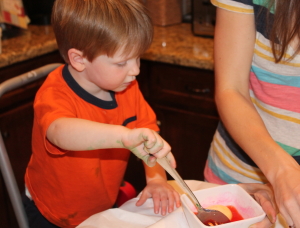Monkey See, [Monkey Hear]- Monkey Do
December 10, 2019Thanksgiving Fruit Turkey
December 10, 2019 As a rambunctious, high-strung kid that talked too much and played even harder, the LAST thing I was worried about on Easter Day was whether the eggs I found were safe to eat or not.
As a rambunctious, high-strung kid that talked too much and played even harder, the LAST thing I was worried about on Easter Day was whether the eggs I found were safe to eat or not.
- They were decorated (by me.)
- It was great to beat my siblings and cousins at finding them. (My mom says I get that from my dad.)
- They were even more fun to peel than they were to hunt.
What else could a kid want?
Fast forward a few years and a couple of food safety classes, and all I have to say is thank goodness for mom!
Here’s the skinny on egg safety:
- When you hard-boil an egg, the cuticle (i.e. the protective outer layer) is washed away.
- With the cuticle gone, it is a lot easier for nasty little illness causing bacteria to get inside the egg through the shell.
- When eggs are allowed to be between 41 F and 135 F (THE DANGER ZONE!!!) the risk of them becoming contaminated increases dramatically.
- Eggs crack, also allowing for possible bacterial contamination.
To minimize the chances of your kids getting sick due to poor egg safety, there are really simple precautions you can take.
After hard-boiling your eggs (careful, not too long in the boiling water- about 15 minutes works!), refrigerate them as soon as possible. Remember the DANGER ZONE? Don’t let your eggs be in it for more than two hours combined.
When you hide them, make sure to keep them away from dirt and nasty places so that the bacteria don’t get through that shell. Throw out any eggs with cracks in them. (No one wants a bad egg!)
Make sure you hide the eggs as close to the hunt as possible to minimize the time the eggs are in the danger zone.
Eat the eggs as soon as your egg hunter finds them, or put them back in refrigeration immediately. And remember, even if you refrigerate them immediately, they’re only good 7 days from the time you boiled them!
Lastly, are you worried about the artificial ingredients in egg dyes? Consider making your own dyes!
It’s really easy to make your own beautiful shades of Easter egg dye using natural ingredients like berries, veggies, coffee, vinegar, and spices like cumin and tumeric.
Berries give you pinks and purples, spinach and green apple peels result in different shades of green, coffee makes brown, cumin or tumeric gives bright yellow, and onion skins (red) give you a varying shade of red.
The recipe is pretty simple: 4 cups of the veggie or fruit (4 Tbsp if you’re using a spice), boiled in 4 cups of water. Then add 2 Tbsp white vinegar and let the solution simmer for half an hour. You’ll need to strain the chunks of food out and then soak your eggs overnight in the leftover dye!
That’s all for this week, yolks!:)

